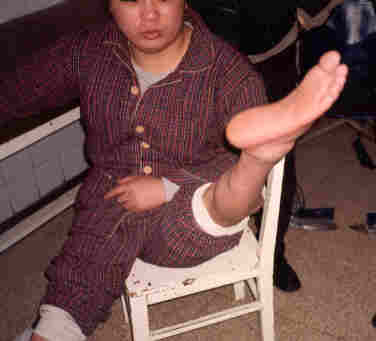|
Restoration of
Stepping-Forward and Ambulatory Function in Individuals with Paraplegia
through the Rerouting of Vascularized Intercostal Nerves to Lumbar Nerve
Roots using Selected Interfascicular Anastomosis |
|
|
Shaocheng Zhang,
Laurance Johnston, Zhenwei Zhang, Yuhai Ma Yuhua Hu,
Jialin Wang, Ping Huang, Shuping Wang,
Department of Orthopedics, Changhai Hospital, Shanghai |
| |

The objective of this
study is to restore stepping-forward and ambulatory function in
paraplegic patients with chronic injuries. Two to four normal obtained
by cutting in the distal end at the midclavicular line. The proximal
ends were disconnected from the levatores costarum. Nerves were then
transferred to the vertebral canal through a submuscle tunnel and
sutured with the selected fascicula of lumbar nerve roots (L1/2
or L3/4) by epiperneurial neurorrhaphy in the subdura or
extradura.
 If the selected intercostal nerve was not of sufficient
length to reach the specific lumbar region, a sural nerve segment
was isolated, sheared into two segments, and attached to the intercostal
nerve for grafting. Twenty-three patients, whose injury sites were
between the thoracic T9 and T12 levels, were
followed postoperatively for a period ranging from 2 to 11
(average: 3.5) years. Of these patients, 18 (78%) regained the
stepping-forward function and were able to walk with crutches or other
ambulatory assistive devices. In addition, 21 (91%) patients had
improved thigh sensation. This intercostal nerve rerouting procedure
restores significant stepping-forward and, in turn, ambulatory function
and thigh-muscle sensation in paraplegic patients. If the selected intercostal nerve was not of sufficient
length to reach the specific lumbar region, a sural nerve segment
was isolated, sheared into two segments, and attached to the intercostal
nerve for grafting. Twenty-three patients, whose injury sites were
between the thoracic T9 and T12 levels, were
followed postoperatively for a period ranging from 2 to 11
(average: 3.5) years. Of these patients, 18 (78%) regained the
stepping-forward function and were able to walk with crutches or other
ambulatory assistive devices. In addition, 21 (91%) patients had
improved thigh sensation. This intercostal nerve rerouting procedure
restores significant stepping-forward and, in turn, ambulatory function
and thigh-muscle sensation in paraplegic patients.
| A full text of this article can be found in
Surgical Technology International XI, June 2003, pp. 242 –246,
available through your library's interlibrary loan procedures. |
|
| |
| |
|
| |
| |
|
| |
| |
|
|